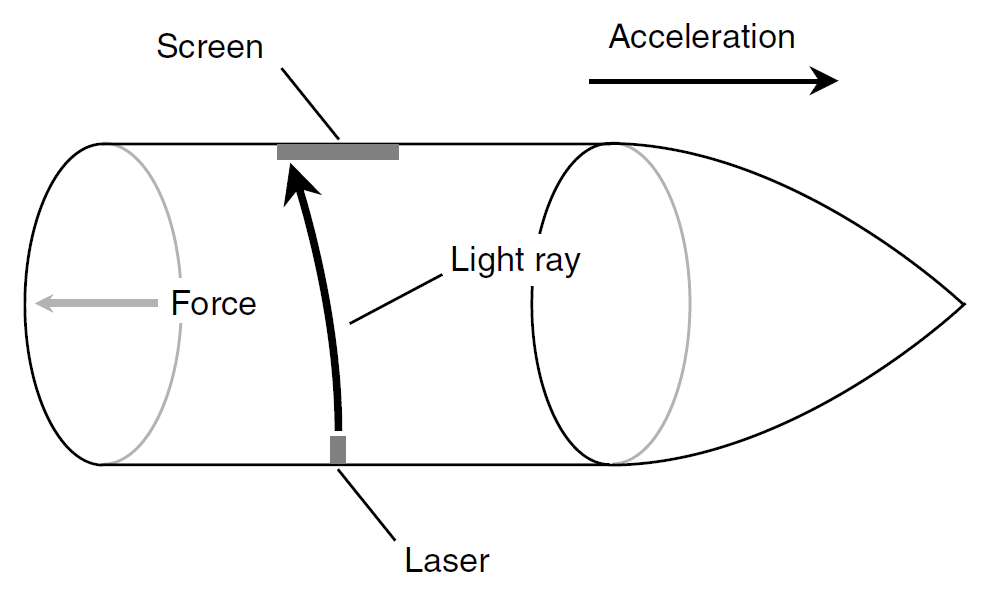
SPATIAL CURVATURE
 المؤلف:
S. Gibilisco
المؤلف:
S. Gibilisco
 المصدر:
Physics Demystified
المصدر:
Physics Demystified
 الجزء والصفحة:
548
الجزء والصفحة:
548
 14-11-2020
14-11-2020
 1792
1792
SPATIAL CURVATURE
Imagine that you are in a space ship traveling through deep space. The ship’s rockets are fired, and the vessel accelerates at an extreme rate. Suppose that the laser apparatus described earlier in this chapter is in the ship, but instead of a mirror on the wall opposite the laser, there is a screen. Before the acceleration begins, you align the laser so that it shines at the center of the screen (Fig. 1). What will happen when the rockets are fired and the ship accelerates?
In a real-life scenario, the spot from the laser will not move on the screen enough for you to notice. This is so because any reasonable (that is, non-life-threatening) rate of acceleration will not cause sufficient force to affect the beam. However, let’s suspend our disbelief and imagine that we can accelerate the vessel at any rate, no matter how great, without being squashed against the ship’s rear wall. If we accelerate fast enough, the ship pulls away from the laser beam as the beam travels across the ship. We, looking at the situation from inside the ship, see the light beam follow a curved path (Fig. 2). A stationary observer on the outside sees the light

Fig. 1. As seen from within the ship, the laser beam travels in straight line across the vessel when it is not accelerating.
beam follow a straight path, but the vessel pulls out ahead of the beam (Fig. 3).
Regardless of the reference frame, the ray of light always follows the shortest possible path between the laser and the screen. When viewed from any nonaccelerating reference frame, light rays appear straight. When observed from accelerating reference frames, however, light rays appear curved. The shortest distance between the two points at opposite ends of the laser beam in Fig. 2 is, in fact, curved. The apparently straight path is in reality longer than the curved one, as seen from inside the accelerating vessel! It is this phenomenon that has led some people to say that “space is curved” in a powerful acceleration field. Because of the principle of equivalence, powerful gravitation causes the same spatial curvature. For spatial curvature to be as noticeable as it appears in Figs. 2 and 3, the vessel must accelerate at an extremely large pace. The standard unit of acceleration is the meter per second per second, or meter per second squared (m/s2). Astronauts and aerospace engineers also express acceleration in units called gravities (symbolized g), where one gravity (1 g) is the acceleration that produces the same force as the gravitational field of the Earth at the surface, approximately 9.8 m/s2. (Don’t confuse the abbreviation for gravity or gravities with the abbreviation for grams! Pay attention to the context if you see a unit symbolized g.) The drawings of Figs. 2 and 3 show the situation for an acceleration of many thousands of gravities. If you weigh 150 pounds on Earth, you will weigh many tons in a ship accelerating at a rate, or in a gravitational field of such intensity, so as to cause that much spatial curvature. Is this a mere academic exercise? Are there actually gravitational fields powerful enough to “bend light rays” significantly? Yes. They exist near the event horizons of black holes.

Fig. 2. As seen from within the ship, the laser beam travels in curved path across the vessel when it is accelerating at a high rate.

Fig. 3. When viewed from a “stationary” reference frame outside the ship, the accelerating vessel pulls away from the straight-line path of the laser beam so that it strikes the screen off-center.
 الاكثر قراءة في النظرية النسبية العامة
الاكثر قراءة في النظرية النسبية العامة
 اخر الاخبار
اخر الاخبار
اخبار العتبة العباسية المقدسة


